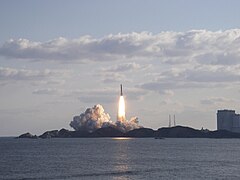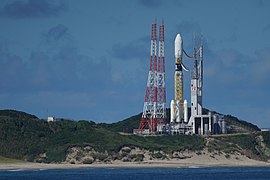
An expendable launch system is a launch vehicle that can be launched only once, after which its components are either destroyed during reentry or discarded in space. ELVs typically consist of several rocket stages that are discarded sequentially as their fuel is exhausted and the vehicle gains altitude and speed. As of 2022, most satellites and human spacecraft are currently launched on ELVs. ELVs are simpler in design than reusable launch systems and therefore may have a lower production cost. Furthermore, an ELV can use its entire fuel supply to accelerate its payload, offering greater payloads. ELVs are proven technology in widespread use for many decades.

Tanegashima (種子島) is one of the Ōsumi Islands belonging to Kagoshima Prefecture, Japan. The island, 444.99 km2 in area, is the second largest of the Ōsumi Islands, and has a population of 33,000 people. Access to the island is by ferry, or by air to New Tanegashima Airport. Administratively, the island is divided into the city, Nishinoomote, and the two towns, Nakatane and Minamitane. The towns belong to Kumage District.

The Japan Aerospace Exploration Agency (JAXA) is the Japanese national air and space agency. Through the merger of three previously independent organizations, JAXA was formed on 1 October 2003. JAXA is responsible for research, technology development and launch of satellites into orbit, and is involved in many more advanced missions such as asteroid exploration and possible human exploration of the Moon. Its motto is One JAXA and its corporate slogan is Explore to Realize.
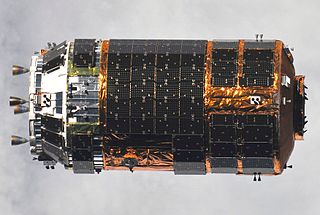
The H-II Transfer Vehicle (HTV), also called Kounotori, is an expendable, automated cargo spacecraft used to resupply the Kibō Japanese Experiment Module (JEM) and the International Space Station (ISS). The Japan Aerospace Exploration Agency (JAXA) has been working on the design since the early 1990s. The first mission, HTV-1, was originally intended to be launched in 2001. It launched at 17:01 UTC on 10 September 2009 on an H-IIB launch vehicle. The name Kounotori was chosen for the HTV by JAXA because "a white stork carries an image of conveying an important thing, therefore, it precisely expresses the HTV's mission to transport essential materials to the ISS". The HTV is very important for resupplying the ISS because after the retirement of the Space Shuttle it is the only vehicle that can transfer new 41.3 in (105 cm) wide International Standard Payload Racks (ISPRs) and dispose old ISPRs that can fit the 51 in (130 cm) wide tunnels between modules in the US Orbital Segment.

H-IIA (H-2A) is an active expendable launch system operated by Mitsubishi Heavy Industries (MHI) for the Japan Aerospace Exploration Agency. These liquid fuel rockets have been used to launch satellites into geostationary orbit; lunar orbiting spacecraft; Akatsuki, which studied the planet Venus; and the Emirates Mars Mission, which was launched to Mars in July 2020. Launches occur at the Tanegashima Space Center. The H-IIA first flew in 2001. As of February 2024, H-IIA rockets were launched 48 times, including 42 consecutive missions without a failure, dating back to 29 November 2003.
RAIKO is a Japanese satellite which was built and operated by Tohoku and Wakayama Universities. A two-unit CubeSat, RAIKO was deployed from the International Space Station (ISS) on 4 October 2012, having been launched on 21 July 2012.

H-IIB (H2B) was an expendable space launch system jointly developed by the Japanese government's space agency JAXA and Mitsubishi Heavy Industries. It was used to launch the H-II Transfer Vehicle cargo spacecraft for the International Space Station. The H-IIB was a liquid-fueled rocket, with solid-fuel strap-on boosters and was launched from the Tanegashima Space Center in southern Japan. H-IIB made its first flight in 2009, and had made a total of nine flights through 2020 with no failures.
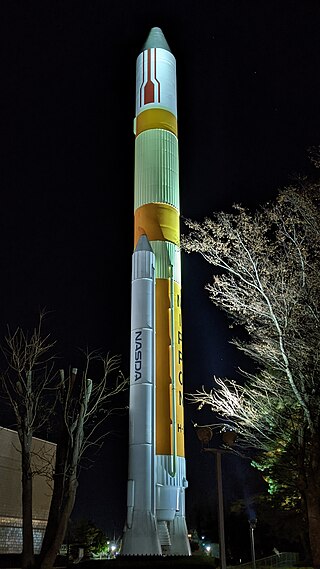
The H-II (H2) rocket was a Japanese satellite launch system, which flew seven times between 1994 and 1999, with five successes. It was developed by NASDA in order to give Japan a capability to launch larger satellites in the 1990s. It was the first two-stage liquid-fuelled rocket Japan made using only technologies developed domestically. It was superseded by the H-IIA rocket following reliability and cost issues.

WINDS, was a Japanese communication satellite. Launch was originally scheduled for 2007. The launch date was eventually set for 15 February 2008, but a problem detected in a second stage maneuvering thruster delayed it to 23 February. Lift-off occurred at 08:55 GMT on 23 February from Tanegashima Space Center, and the satellite separated from its H-IIA carrier rocket into a Geosynchronous transfer orbit at 09:23. WINDS was used to relay the internet to Japanese homes and businesses through Ka-Band signals. It also tested technologies that would be utilised by future Japanese communication satellites. A part of Japan's i-Space program, WINDS was operated by JAXA and NICT.
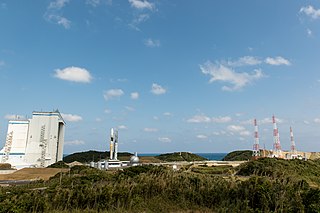
Yoshinobu Launch Complex (LC-Y) is a rocket launch site at the Tanegashima Space Center on Tanegashima. The site and its collection of facilities were originally built for the H-II launch vehicle and later used for H-IIA, H-IIB and H3 launches.

HTV-1, also known as the HTV Demonstration Flight or HTV Technical Demonstration Vehicle, was the first flight of the Japanese Space Agency (JAXA) H-II Transfer Vehicle, launched in September 2009 to resupply the International Space Station and support the JAXA Kibō module or Japanese Experiment Module (JEM). It was an uncrewed cargo spacecraft carrying a mixture of pressurised and unpressurised cargo to the International Space Station. After a 52-day successful mission, HTV departed the ISS on 31 October 2009 after being released by the station's robotic arm. The spacecraft re-entered in the atmosphere of Earth on 1 November 2009 and disintegrated on re-entry as planned.
Shin'en, known before launch as UNITEC-1 or UNISEC Technology Experiment Carrier 1, is a Japanese student spacecraft which was intended to make a flyby of Venus in order to study the effects of interplanetary spaceflight on spacecraft computers. In doing so, it was intended to become the first student-built spacecraft to operate beyond geocentric orbit. It was operated by UNISEC, a collaboration between several Japanese universities.
Waseda-SAT2 is a Japanese satellite which launched in May 2010. It is a student-built spacecraft, which will be operated by Waseda University, and is intended to be used for Earth observation and technology demonstration. It will test the use of extendible paddles to provide attitude control. The satellite is a single unit CubeSat.
Hayato, known before launch as KSAT, or the Kagoshima Satellite, is a Japanese satellite which was launched on 20 May 2010. It is a student-built spacecraft, which is operated by Kagoshima University, and is being used for technology demonstration and atmospheric research. The satellite is a single unit CubeSat, and carries equipment to study water vapour in the Earth's atmosphere, microwave imagery and spacecraft communication.
Negai☆″ is a Japanese satellite which launched in May 2010. It is a student-built spacecraft, which will be operated by Soka University, and is intended to be used for technology demonstration. The satellite is a single unit CubeSat, and will be used to test a field programmable gate array in orbit. As part of an outreach programme, it will carry the names of selected children, along with wishes they have made. The satellite will return images of the Earth, which will be given to the participating children.

Global Precipitation Measurement (GPM) is a joint mission between JAXA and NASA as well as other international space agencies to make frequent observations of Earth's precipitation. It is part of NASA's Earth Systematic Missions program and works with a satellite constellation to provide full global coverage. The project provides global precipitation maps to assist researchers in improving the forecasting of extreme events, studying global climate, and adding to current capabilities for using such satellite data to benefit society. GPM builds on the notable successes of the Tropical Rainfall Measuring Mission (TRMM), which was also a joint NASA-JAXA activity.

The Japanese space program originated in the mid-1950s as a research group led by Hideo Itokawa at the University of Tokyo. The size of the rockets produced gradually increased from under 30 cm (12 in) at the start of the project, to over 15 m (49 ft) by the mid-1960s. The aim of the original research project was to launch a man-made satellite.

Kounotori 3, also known as HTV-3, was the third flight of the Japanese H-II Transfer Vehicle. It was launched on 21 July 2012 to resupply the International Space Station (ISS) aboard the H-IIB Launch Vehicle No. 3 manufactured by Mitsubishi Heavy Industries (MHI) and JAXA. Kounotori 3 arrived at the ISS on 27 July 2012, and Expedition 32 Flight Engineer and JAXA astronaut Akihiko Hoshide used the International Space Station's Canadarm2 robotic arm to install Kounotori 3, to its docking port on the Earth-facing side (nadir) of the Harmony module at 14:34 UTC.
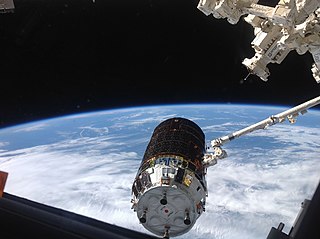
Kounotori 4, also known as HTV-4, was the fourth flight of the H-II Transfer Vehicle, an uncrewed cargo spacecraft launched in August 2013 to resupply the International Space Station. It launched from Tanegashima Space Center aboard H-IIB No. 4 rocket on 3 August 2013 and connected to ISS by 9 August 2013; it carried 5,400 kilograms (11,900 lb) of cargo. Kounotori 4 undocked on 4 September 2013 and was destroyed by reentry on 7 September 2013.




